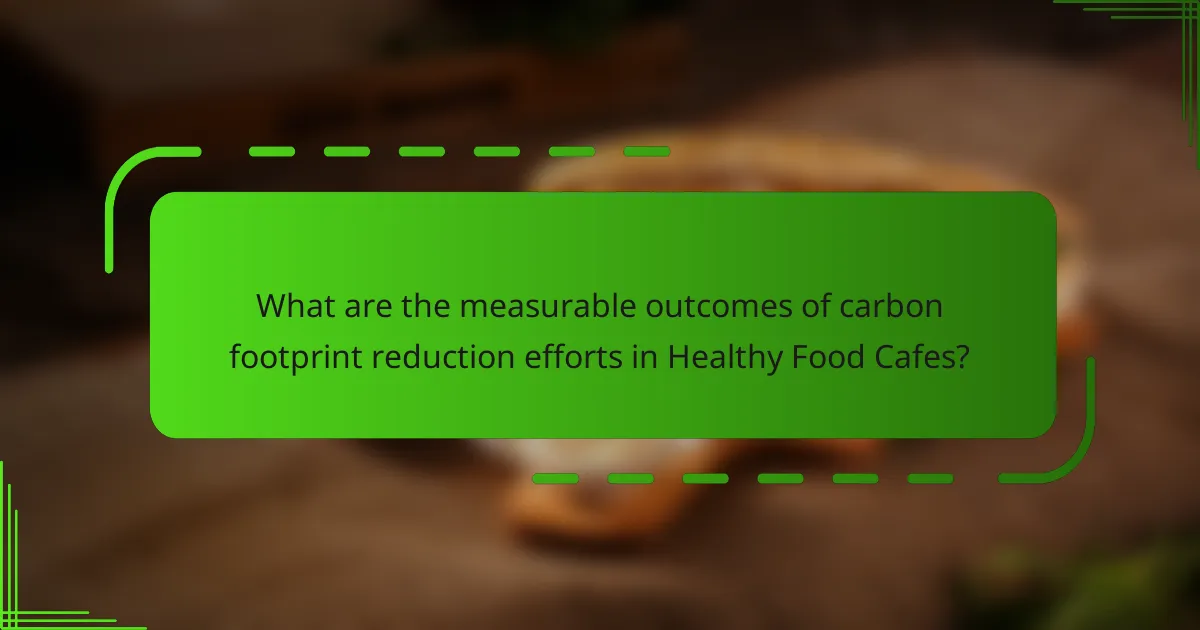Healthy Food Cafes are increasingly focused on carbon footprint reduction through several sustainable practices. These cafes prioritize sourcing local and organic ingredients to minimize transportation emissions and support sustainable farming. They often feature plant-based menus, which contribute to lower greenhouse gas emissions compared to animal products. Additionally, eco-friendly packaging, energy-efficient appliances, and waste reduction strategies, such as composting and recycling, are commonly implemented. Community initiatives further enhance awareness of sustainability and healthy eating, leading to measurable outcomes like reduced emissions and increased customer loyalty.

What are Carbon Footprint Reduction Efforts by Healthy Food Cafes?
Healthy food cafes implement various carbon footprint reduction efforts. They prioritize sourcing local and organic ingredients. This practice minimizes transportation emissions and supports sustainable farming. Many cafes also adopt plant-based menus. Plant-based foods generally have a lower carbon footprint than animal products.
Additionally, these cafes often use eco-friendly packaging. Compostable or reusable containers reduce waste and pollution. Some cafes engage in community initiatives. They promote awareness about sustainability and healthy eating.
Energy-efficient appliances are frequently utilized. This reduces energy consumption and lowers greenhouse gas emissions. Lastly, many cafes practice waste reduction strategies. They compost food scraps and recycle materials to minimize landfill contributions.
How do Healthy Food Cafes contribute to reducing carbon footprints?
Healthy food cafes contribute to reducing carbon footprints by prioritizing local and organic ingredients. Sourcing food locally minimizes transportation emissions. Organic farming practices reduce reliance on synthetic fertilizers and pesticides. Many cafes adopt plant-based menus, which have a lower carbon footprint than meat-based options. They often use sustainable packaging to decrease plastic waste. By promoting seasonal produce, they align with natural growing cycles, reducing energy consumption. Additionally, these cafes frequently implement waste reduction strategies, such as composting. These practices collectively lead to lower greenhouse gas emissions and a smaller overall carbon footprint.
What practices do Healthy Food Cafes implement for sustainability?
Healthy food cafes implement various practices for sustainability. They often source ingredients locally to reduce transportation emissions. Many cafes prioritize organic produce to avoid harmful pesticides. They also use biodegradable or compostable packaging to minimize waste. Some cafes implement energy-efficient appliances to reduce energy consumption. Additionally, they may offer plant-based menu options, which have a lower carbon footprint than meat-based dishes. Many cafes engage in composting food waste to enrich soil and reduce landfill contributions. These practices collectively contribute to a significant reduction in their overall environmental impact.
How do sourcing and supply chain choices impact carbon footprints?
Sourcing and supply chain choices significantly impact carbon footprints. Sustainable sourcing reduces emissions by selecting local suppliers, minimizing transportation distances. This leads to lower fuel consumption and decreased greenhouse gas emissions. Additionally, sourcing organic or regenerative products can enhance soil health and carbon sequestration. Efficient supply chain management optimizes logistics and reduces waste, further decreasing carbon outputs. According to the Carbon Trust, transportation can account for up to 30% of a product’s total carbon footprint. Therefore, strategic sourcing and supply chain decisions are crucial in mitigating environmental impacts.
Why is it important for Healthy Food Cafes to focus on carbon footprint reduction?
Healthy food cafes should focus on carbon footprint reduction to promote sustainability. Reducing carbon emissions can significantly lower environmental impact. Health-conscious consumers increasingly prefer businesses that prioritize eco-friendly practices. Statistics show that the food industry contributes about 25% of global greenhouse gas emissions. By implementing sustainable sourcing and waste management, cafes can minimize their carbon footprint. This approach not only attracts environmentally aware customers but also enhances brand reputation. Additionally, carbon footprint reduction can lead to cost savings through efficient resource use. Therefore, focusing on this issue aligns with both ethical responsibility and business viability.
What environmental benefits arise from reducing carbon footprints?
Reducing carbon footprints leads to significant environmental benefits. It lowers greenhouse gas emissions, which contribute to climate change. A decrease in emissions helps mitigate global warming. This results in improved air quality. Better air quality can lead to health benefits for ecosystems and humans alike. Additionally, reducing carbon footprints conserves natural resources. Efficient resource use supports biodiversity and ecosystem stability. Studies indicate that sustainable practices can reduce energy consumption by up to 30%. This reduction further decreases environmental degradation.
How does carbon footprint reduction align with consumer values?
Carbon footprint reduction aligns with consumer values by reflecting a commitment to sustainability. Many consumers prioritize eco-friendly practices and seek brands that share these values. Research indicates that 66% of global consumers are willing to pay more for sustainable brands. This willingness is driven by a growing awareness of climate change and environmental impact. Consumers view carbon footprint reduction as a way to contribute positively to the planet. Healthy food cafes that adopt these practices attract environmentally conscious customers. This alignment fosters brand loyalty and enhances the overall customer experience.
What challenges do Healthy Food Cafes face in their carbon footprint reduction efforts?
Healthy food cafes face several challenges in reducing their carbon footprint. Sourcing local and organic ingredients can be difficult due to availability and cost. Many healthy food cafes struggle with higher prices for sustainable products. Additionally, limited access to eco-friendly packaging options can hinder their efforts. Transportation emissions from ingredient delivery also contribute to their overall carbon footprint. Cafes often lack the resources to implement comprehensive waste management practices. Staff training on sustainability practices can be inconsistent, affecting overall impact. Finally, consumer demand for convenience may conflict with sustainable practices, complicating their carbon reduction strategies.
What are common obstacles in sourcing sustainable ingredients?
Common obstacles in sourcing sustainable ingredients include limited availability, higher costs, and inconsistent quality. Limited availability arises when sustainable options are not widely produced or distributed. Higher costs can deter cafes from sourcing these ingredients, as they often come at a premium compared to conventional options. Inconsistent quality may lead to challenges in maintaining menu standards. Additionally, lack of supplier transparency can complicate the sourcing process. According to a 2021 report by the Food and Agriculture Organization, 70% of food businesses face challenges in securing sustainable ingredients, underscoring the significance of these obstacles.
How do operational costs affect sustainability initiatives?
Operational costs significantly impact sustainability initiatives by influencing resource allocation and investment decisions. High operational costs can limit the financial resources available for implementing sustainable practices. For example, if a healthy food cafe faces rising energy costs, it may prioritize short-term savings over long-term sustainability investments. This can result in reduced efforts to adopt energy-efficient appliances or sustainable sourcing of ingredients. Conversely, lower operational costs may free up funds for initiatives like waste reduction programs or renewable energy sources. A study by the World Resources Institute found that businesses that manage operational costs effectively can reinvest savings into sustainability, enhancing their overall environmental performance.

What specific strategies are Healthy Food Cafes using to reduce their carbon footprints?
Healthy Food Cafes are employing various strategies to reduce their carbon footprints. They prioritize sourcing local and organic ingredients to minimize transportation emissions. Many cafes implement plant-based menus, which significantly lower greenhouse gas emissions compared to meat-based options. Additionally, they adopt sustainable packaging solutions, such as compostable or reusable containers, to reduce waste. Energy-efficient appliances are commonly used to decrease energy consumption. Furthermore, some cafes engage in community initiatives, like urban gardening, to promote local food production. These strategies collectively contribute to a smaller environmental impact, aligning with the cafes’ commitment to sustainability.
How do menu design and food waste management contribute to sustainability?
Menu design and food waste management significantly contribute to sustainability. Effective menu design can reduce food waste by promoting dishes that utilize seasonal and local ingredients. This approach minimizes transportation emissions and supports local economies. Studies show that menus featuring smaller portion sizes can lead to less food waste. Additionally, clear labeling of ingredients and sustainability practices on menus can inform customers, encouraging mindful consumption.
Food waste management practices, such as composting and donating surplus food, further enhance sustainability. According to the Food and Agriculture Organization, approximately one-third of food produced globally is wasted. By implementing waste reduction strategies, cafes can lower their carbon footprint and conserve resources. Sustainable practices in both menu design and waste management create a more environmentally friendly dining experience.
What are effective ways to minimize food waste in cafes?
Implementing portion control is an effective way to minimize food waste in cafes. This strategy involves serving smaller portions to reduce leftovers. Tracking inventory helps cafes manage stock levels accurately. By knowing what items are frequently wasted, cafes can adjust their purchasing decisions.
Offering daily specials can utilize surplus ingredients that might otherwise go to waste. This practice encourages creativity in menu planning while reducing excess stock. Educating staff about food waste can promote awareness and responsibility in handling ingredients.
Additionally, donating unsold food to local charities can ensure that excess food serves a purpose. According to the Food Waste Reduction Toolkit by the USDA, cafes that adopt these practices can significantly decrease their food waste.
How does menu planning impact ingredient sourcing and carbon emissions?
Menu planning significantly impacts ingredient sourcing and carbon emissions. Thoughtful menu planning prioritizes local and seasonal ingredients. This reduces transportation distances, which lowers carbon emissions. For instance, sourcing ingredients from nearby farms can decrease food miles by up to 90%. Additionally, menu planning can minimize food waste by aligning ingredient quantities with demand. Reducing waste further cuts down on carbon emissions associated with disposal. A study by the Food and Agriculture Organization (FAO) indicates that food waste contributes to 8-10% of global greenhouse gas emissions. Therefore, effective menu planning can lead to more sustainable ingredient sourcing and lower overall carbon footprints.
What role does community engagement play in carbon footprint reduction?
Community engagement plays a crucial role in carbon footprint reduction. It fosters collective action among individuals, businesses, and organizations. Engaged communities are more likely to adopt sustainable practices. These practices include reducing waste, recycling, and promoting energy efficiency. Studies show that communities with strong engagement initiatives reduce their carbon emissions significantly. For instance, a report from the Carbon Trust highlights that community-led projects can decrease emissions by up to 30%. This engagement also raises awareness about climate change and encourages behavioral changes. Ultimately, community involvement amplifies the impact of individual actions on reducing carbon footprints.
How can Healthy Food Cafes collaborate with local farmers?
Healthy food cafes can collaborate with local farmers by sourcing ingredients directly from them. This practice supports local agriculture and reduces transportation emissions. Establishing partnerships allows cafes to offer seasonal menus featuring fresh produce. By participating in community-supported agriculture (CSA) programs, cafes can secure a steady supply of local goods. Hosting farmer’s markets or events promotes local farmers and increases community awareness. Additionally, cafes can engage in educational programs about sustainable farming practices. This collaboration not only enhances the cafe’s menu but also strengthens local economies. Research shows that local sourcing can reduce carbon footprints significantly, as it minimizes the distance food travels.
What initiatives can cafes implement to educate customers about sustainability?
Cafes can implement various initiatives to educate customers about sustainability. They can host workshops on sustainable practices, such as composting and recycling. Cafes can provide informational materials, like brochures and posters, detailing their sustainability efforts. Collaborating with local environmental organizations can enhance educational outreach. Offering discounts for customers who bring reusable containers promotes eco-friendly behavior. Cafes can also feature a menu that highlights sustainable ingredients, explaining their sourcing. Using social media to share tips on reducing carbon footprints can engage a broader audience. Partnering with local farms can showcase the benefits of supporting local agriculture. These initiatives foster a culture of sustainability among customers.

What are the measurable outcomes of carbon footprint reduction efforts in Healthy Food Cafes?
Measurable outcomes of carbon footprint reduction efforts in Healthy Food Cafes include reduced greenhouse gas emissions and lower energy consumption. Many cafes adopt sustainable sourcing, resulting in a decrease in carbon output from transportation. Implementing energy-efficient appliances can lead to a 20-30% reduction in energy use. Waste reduction practices contribute to lowering landfill contributions, which can decrease methane emissions. Additionally, customer engagement in sustainability initiatives can increase, reflecting a shift in consumer behavior towards eco-friendly choices. Studies indicate that cafes reducing their carbon footprint often see increased customer loyalty and sales, as consumers prefer environmentally responsible businesses.
How can Healthy Food Cafes track their carbon footprint reduction progress?
Healthy food cafes can track their carbon footprint reduction progress by implementing a systematic measurement approach. They can use carbon accounting software to quantify emissions from various operations. This includes sourcing ingredients, energy consumption, and waste management. Regularly updating this data allows cafes to monitor changes over time. They can also set specific reduction targets based on baseline measurements. Engaging in carbon footprint assessments annually provides insights into progress. Collaborating with sustainability organizations can enhance tracking accuracy. These methods collectively ensure informed decision-making for further reduction efforts.
What metrics are used to measure sustainability in food services?
Sustainability in food services is measured using various metrics. Common metrics include carbon footprint, water usage, and waste generation. Carbon footprint quantifies greenhouse gas emissions from food production and service. Water usage metrics track the amount of water consumed in food preparation and service. Waste generation metrics assess the volume of food waste produced. Additional metrics include energy consumption and sourcing of ingredients. Energy consumption measures the electricity and gas used in operations. Sourcing metrics evaluate the sustainability of food procurement practices. These metrics provide a comprehensive view of sustainability efforts in food services.
How can cafes report their sustainability achievements to customers?
Cafes can report their sustainability achievements to customers through various methods. They can display certifications such as Fair Trade or organic labels prominently. This provides visual proof of their commitment to sustainable practices. Cafes can also use signage to highlight specific initiatives, like waste reduction or sourcing local ingredients. Sharing success stories on social media platforms engages customers and informs them about sustainable efforts. Regularly updating their website with sustainability reports can provide detailed insights into their achievements. Additionally, hosting community events focused on sustainability can foster transparency and customer involvement. These methods help build trust and awareness among customers regarding the cafes’ sustainability efforts.
What best practices can Healthy Food Cafes adopt for effective carbon footprint reduction?
Healthy food cafes can adopt several best practices for effective carbon footprint reduction. Sourcing local and organic ingredients minimizes transportation emissions. Implementing plant-based menus reduces the carbon intensity of meals. Utilizing energy-efficient appliances lowers energy consumption significantly. Composting food waste diverts waste from landfills and reduces methane emissions. Offering reusable containers encourages customers to reduce single-use plastics. Providing digital menus decreases paper waste. Educating staff and customers about sustainability promotes environmentally friendly practices. These strategies collectively contribute to a meaningful reduction in carbon footprints.
What resources are available for cafes looking to improve sustainability?
Cafes looking to improve sustainability can access various resources. These include guides from organizations like the Sustainable Food Trust. They provide practical tips for reducing waste and sourcing local ingredients. The Green Restaurant Association offers certification programs that help cafes implement sustainable practices. Online platforms like Food Waste Reduction Toolkit provide strategies for minimizing food waste. Additionally, local government initiatives often support sustainable business practices with grants and training. Research shows that implementing these resources can lead to a significant reduction in carbon footprints. For instance, cafes that adopt sustainable practices can reduce their waste by up to 50%.
How can cafes create a culture of sustainability among staff and customers?
Cafes can create a culture of sustainability among staff and customers by implementing eco-friendly practices. They can start by sourcing local and organic ingredients to reduce transportation emissions. Training staff on sustainability practices fosters a knowledgeable team. Engaging customers through workshops on sustainable living encourages active participation. Offering discounts for reusable containers promotes eco-conscious behavior. Cafes can also utilize composting and recycling programs to minimize waste. Research shows that 73% of consumers prefer brands that practice sustainability. By demonstrating commitment to sustainability, cafes can enhance their reputation and customer loyalty.
The main entity of this article is “Healthy Food Cafes” and their efforts in carbon footprint reduction. The article outlines various strategies these cafes implement, including sourcing local and organic ingredients, adopting plant-based menus, utilizing eco-friendly packaging, and engaging in waste reduction practices. It discusses the importance of sustainability in attracting health-conscious consumers and the measurable outcomes of these initiatives, such as reduced greenhouse gas emissions and increased customer loyalty. Additionally, the article highlights challenges faced by cafes and best practices for effective carbon footprint reduction, emphasizing the role of community engagement and education in fostering a culture of sustainability.